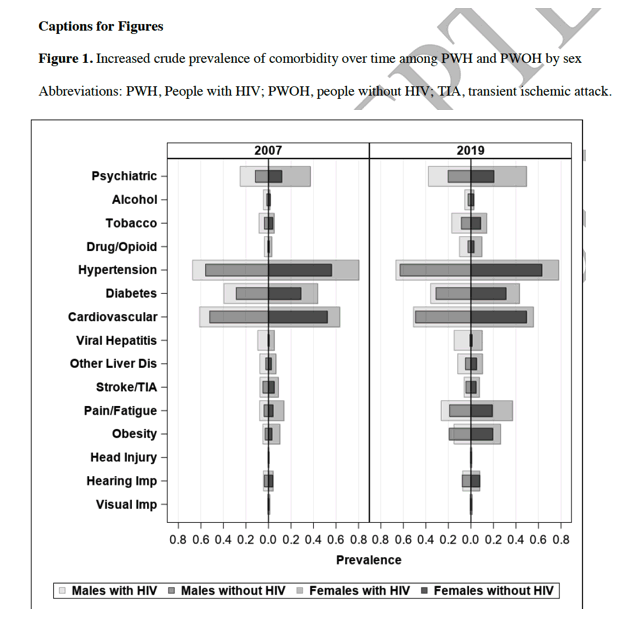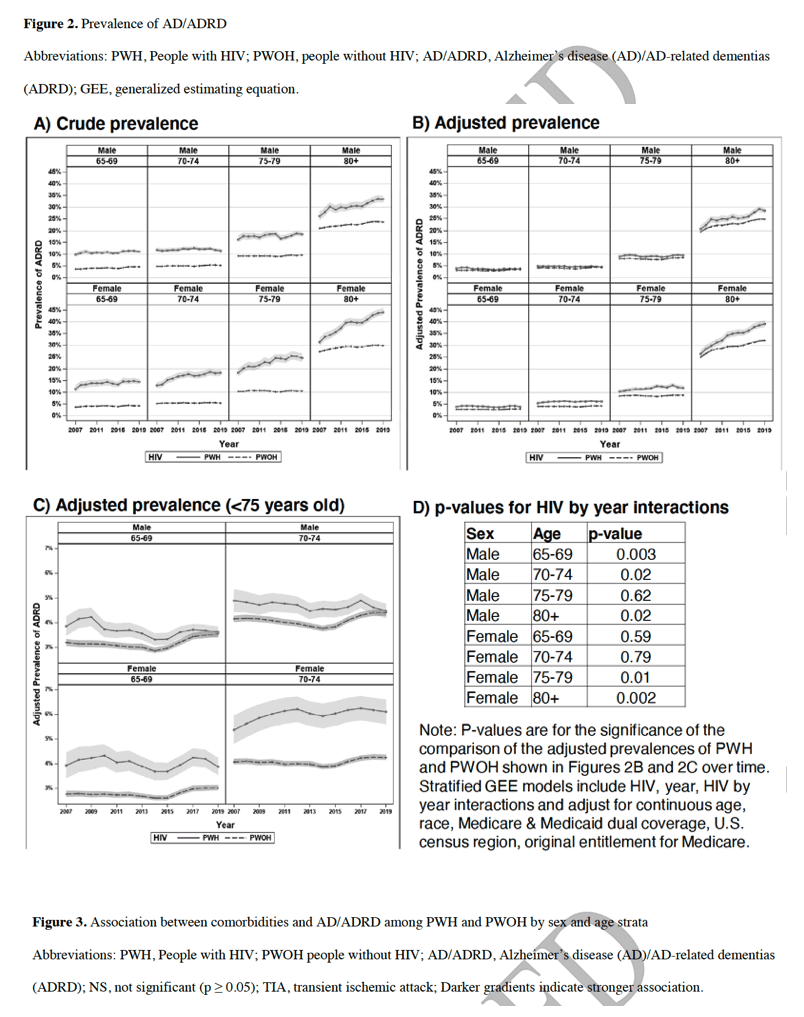| |
Dementias among older males and females
in the U.S. Medicare system with and without HIV
|
| |
| |
Yu, Xiaoying MD, PhD1,2; Kuo, Yong-Fang PhD1,2; Raji, Mukaila A. MD3; Berenson, Abbey B. MD, PhD2,4; Baillargeon, Jacques PhD5; Giordano, Thomas P. MD, MPH6,7
JAIDS March 06, 2023
Download the PDF
Given that older age is the main risk factor for dementia, the prolonged life expectancy among PWH will contribute to an increase in the prevalence of AD/ADRD in this population.
This study found that PWH had a higher prevalence of AD/ADRD, which increased over time compared with PWOH, especially among female beneficiaries. The differences between PWH and PWOH largely decreased after adjustment for demographics and comorbidities. However, differences in dementia burden remained, especially among older age groups. We also found a spectrum of comorbidities associated with AD/ADRD, with psychiatric disorders the most prominent among these.
Among all comorbidities, the top 5 conditions associated with AD/ADRD were psychiatric disorders, head injury, stroke/TIA, alcohol abuse disorder, and cardiovascular diseases in both PWH and PWOH. Particularly, for psychiatric disorders, the ORs (95% CI) ranged from 1.61 (1.55, 1.67) to 2.26 (2.14, 2.37) and 1.61 (1.60, 1.62) to 2.52 (2.45, 2.59) for PWH and PWOH respectively, with stronger associations in younger age groups and among females.
There was also a large increase in the proportion of PWH with disabled/end-stage renal disease (ESRD) as the original Medicare entitlement in both males (29.6% vs. 44.9%) and females (21.4% vs. 40.6%). The increase in the number of comorbidities over time was more pronounced in PWH and females, especially for psychiatric disorders, tobacco/drug/opioid use disorders, viral hepatitis/liver diseases, pain/fatigue, and obesity (Figure 1).
CD4 nadir is a predictor of HIV neurocognitive impairment and initiation of ART as early as possible might reduce the risk of developing HIV-associated neurocognitive disorders.44 In contrast, it is possible that long-term exposure to certain ART drugs may cause chronic CNS toxicity.45-47
The strong association between psychiatric disorders (e.g., depression) and AD/ADRD may be explained by several reasons. Depression can impair cognitive function leading to a "pseudodementia" presentation.37 Loneliness, social isolation and heavy alcohol use,38,39 major psychosocial consequences of depression and especially prominent among PWH, are risk factors for dementia.35 Depression and cognitive impairment may also represent the same underlying pathological process, perhaps due to direct and indirect effects of HIV replication in the central nervous system (CNS).40 Toxoplasmosis is a common central nervous system infection in PWH41 and some studies have demonstrated negative e
The strong association between psychiatric disorders (e.g., depression) and AD/ADRD may be explained by several reasons. Depression can impair cognitive function leading to a "pseudodementia" presentation.37 Loneliness, social isolation and heavy alcohol use,38,39 major psychosocial consequences of depression and especially prominent among PWH, are risk factors for dementia.35 Depression and cognitive impairment may also represent the same underlying pathological process, perhaps due to direct and indirect effects of HIV replication in the central nervous system (CNS).40 Toxoplasmosis is a common central nervous system infection in PWH41 and some studies have demonstrated negative e
Dementia is a major neurocognitive disorder that manifests as impairment in thinking, executive function, learning, social cognition, memory, language, and other cognitive functions severe enough to interfere with daily activities.9 Aging is the primary risk factor for dementia in the general population. The prevalence of Alzheimer's disease (AD) and AD-related dementias (ADRD) doubles for every 5-year interval beyond age 65.10 Many aging-related comorbidities contributing to cognitive decline-such as cardiovascular disease, hypertension, diabetes mellitus, stroke, and depression-are more prevalent in PWH.11-14 Other risk factors, including substance use, low education, social isolation, and sedentary lifestyle, are also more common in PWH.15 In addition, PWH are exposed to HIV-related biomechanisms of neurological change, including a persistent state of low-grade inflammation,16,17 cumulative exposure to ART,18-21 and increased aging-related comorbidities,11-14 which may augment the progression of dementia. These factors increase the concern that PWH will experience a disproportionate burden of dementia as they age.
Abstract
Background:
Despite the growing concern that people with HIV (PWH) will experience a disproportionate burden of dementia as they age, very few studies have examined the sex-specific prevalence of dementia, including Alzheimer's disease and related dementias (AD/ADRD) among older PWH versus people without HIV (PWOH) using large national samples.
Methods:
We constructed successive cross-sectional cohorts including all PWH aged 65+ years from U.S. Medicare enrollees and PWOH in a 5% national sample of Medicare data from 2007 to 2019. All AD/ADRD cases were identified by ICD-9-CM/ICD-10-CM diagnosis codes. Prevalence of AD/ADRD was calculated for each calendar year by sex-age strata. Generalized estimating equations were used to assess factors associated with dementia and calculate the adjusted prevalence.
Results:
PWH had a higher prevalence of AD/ADRD which increased over time compared with PWOH, especially among female beneficiaries and with increasing age. For example, among those aged 80+ years, the prevalence increased from 2007 to 2019 (females with HIV: 31.4% to 44.1%; females without HIV: 27.4% to 29.9%; males with HIV: 26.2% to 33.3%; males without HIV: 21.0% to 23.5%). After adjustment for demographics and comorbidities, the differences in dementia burden by HIV status remained, especially among older age groups.
Conclusions:
Older Medicare enrollees with HIV had an increased dementia burden over time compared to those without HIV, especially females and older subjects. This underscores the need to develop tailored clinical practice guidelines that facilitate the integration of dementia and comorbidity screening, evaluation, and management into the routine primary care of aging PWH.
Within each age stratum, we found that PWH had a higher burden of dementia, which increased faster compared to PWOH, in both males and females. The oldest groups were most impacted, especially among females. These findings were confounded or moderated by differential demographic and comorbid characteristics and reflect the fact that older PWH increasingly develop age-related comorbidities and psychiatric disorders which impact cognitive function and are often more common in females. Alcohol/drug/opioid use disorders were also more common in PWH and increased over time. After adjusting for demographic factors and comorbidities, the differences between PWH and PWOH decreased in all strata, although significant gaps remained among those 80 years and older. That the gaps between PWH and PWOH were larger in females than in males for all age strata suggests that the excessive burden of AD/ADRD in females with HIV cannot be accounted by differences in demographics and comorbidities. We also found that many age-related comorbidities were highly associated with dementia among PWH. Compared to PWOH, the lower OR (i.e., smaller relative measure) in PWH reflects the observation that there were higher odds of AD/ADRD among PWH without a particular comorbidity.



|
|
| |
| |
|
|
|